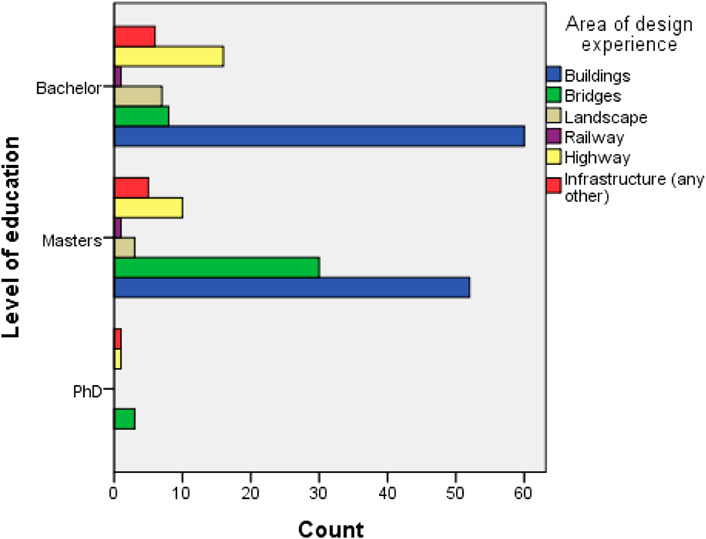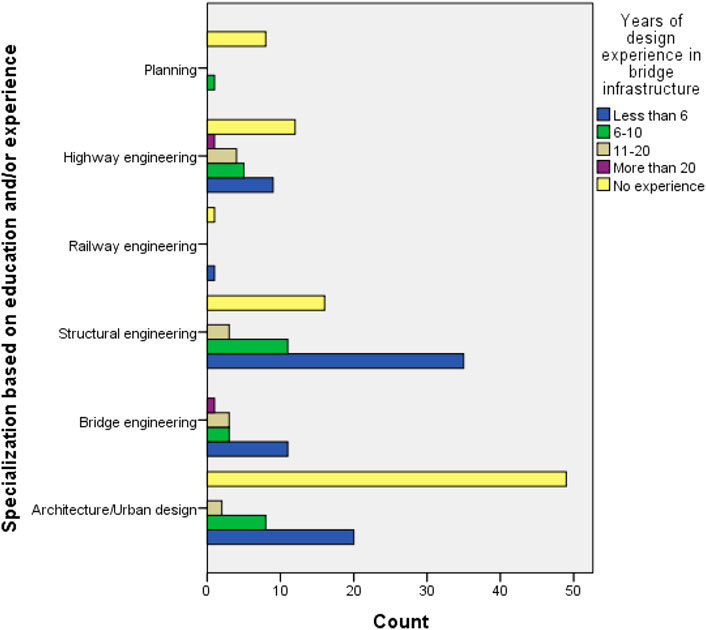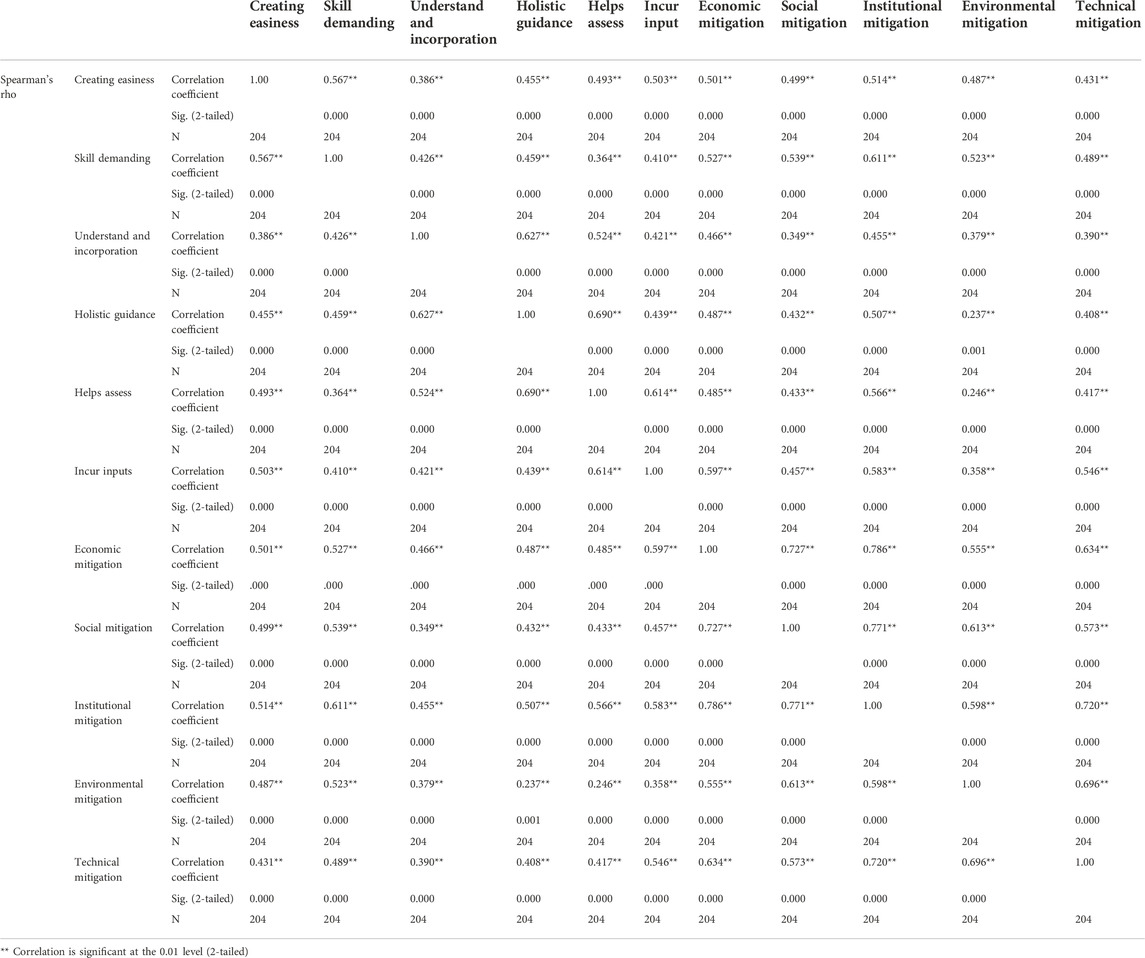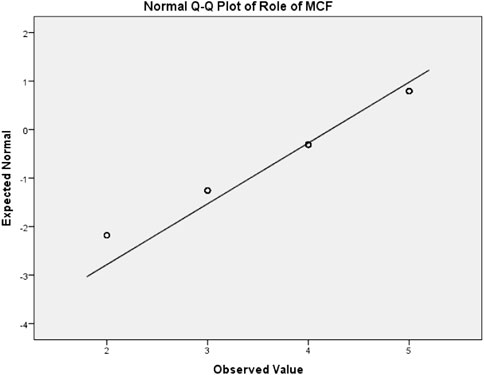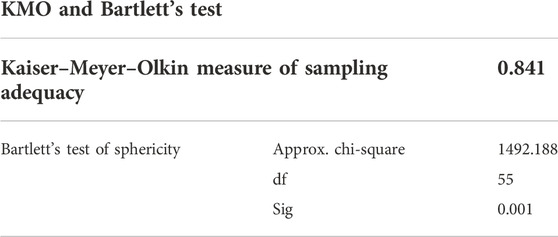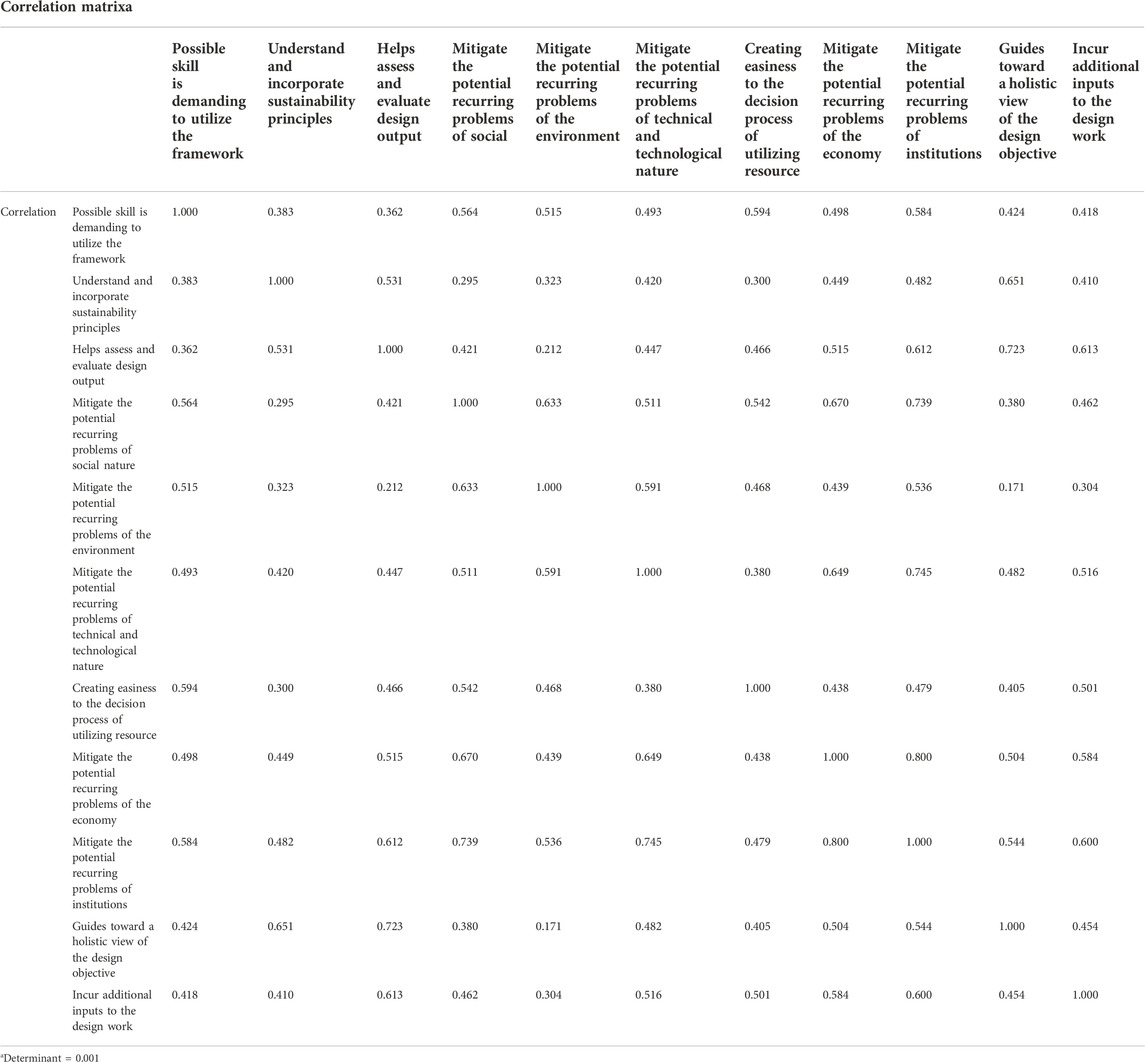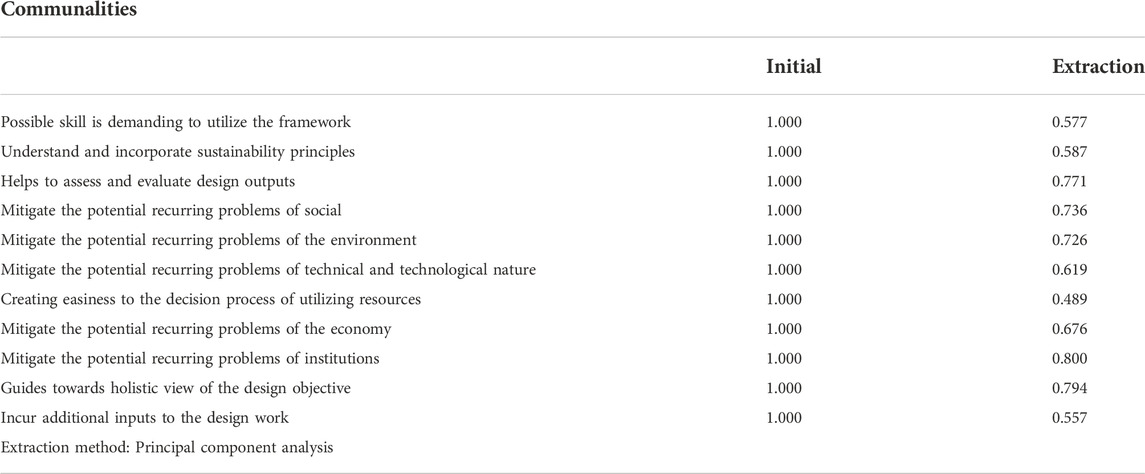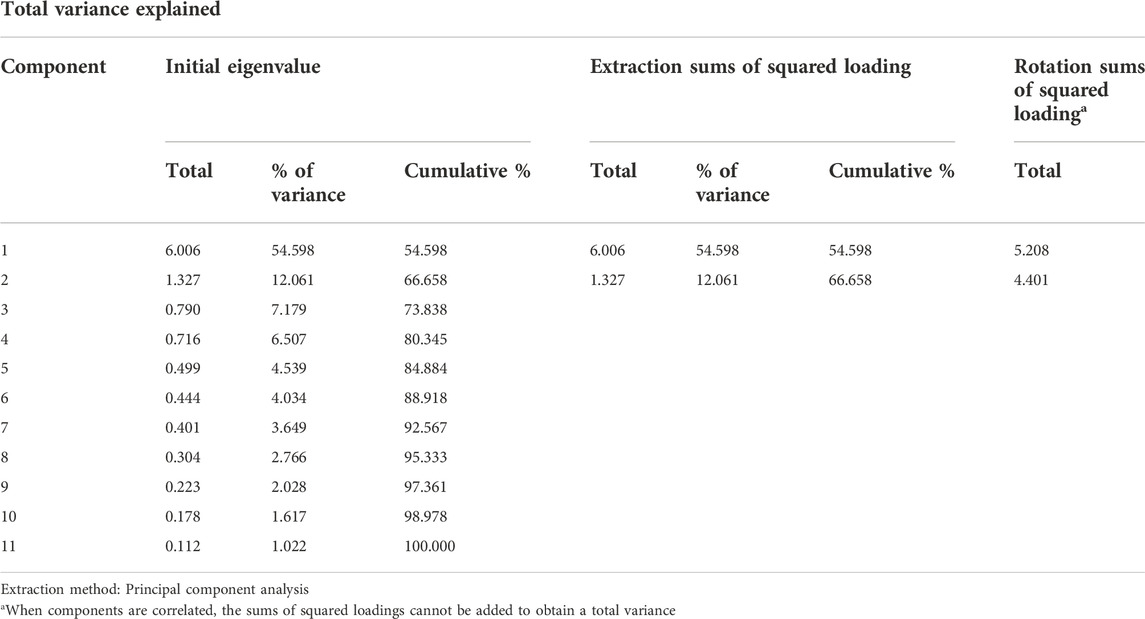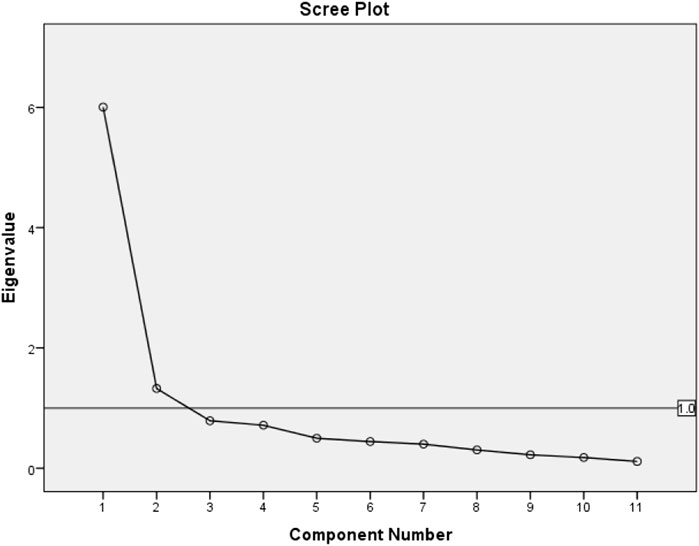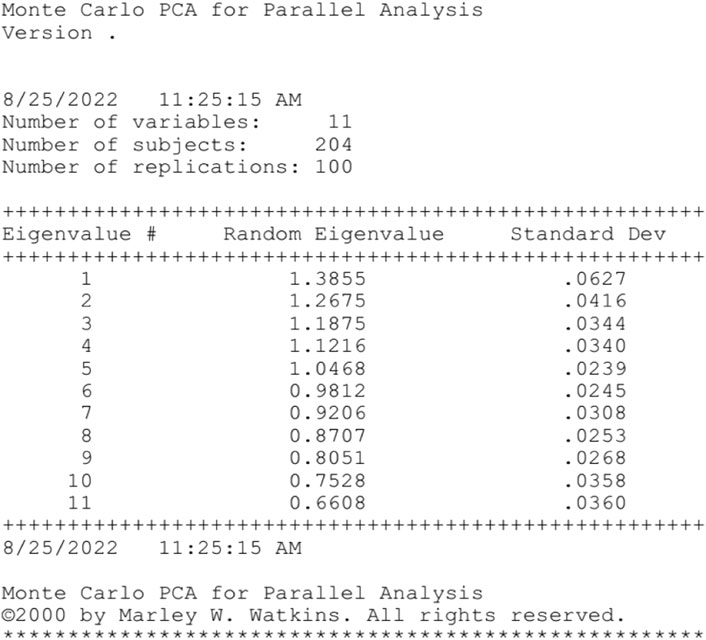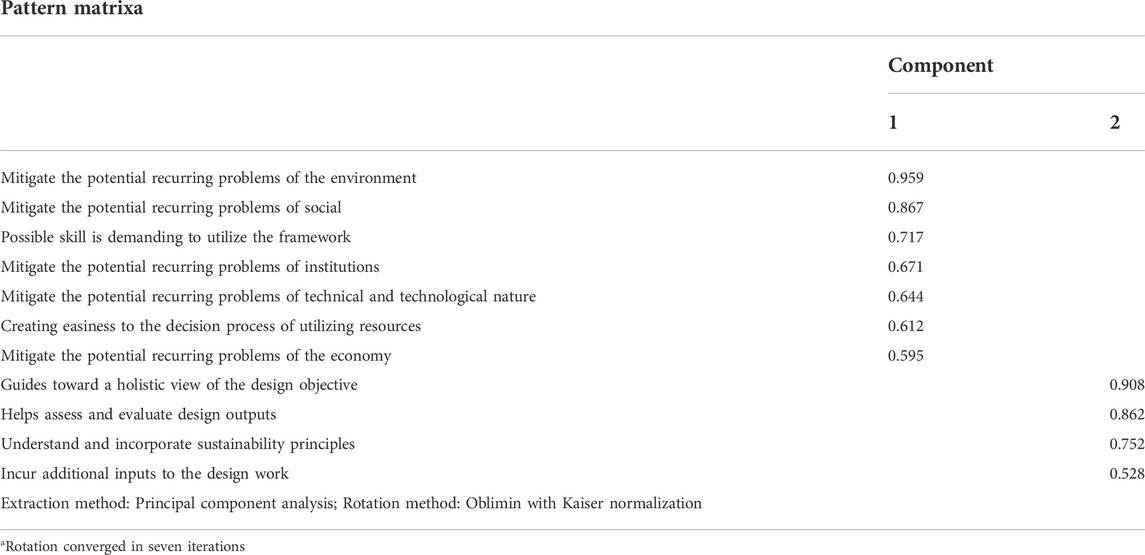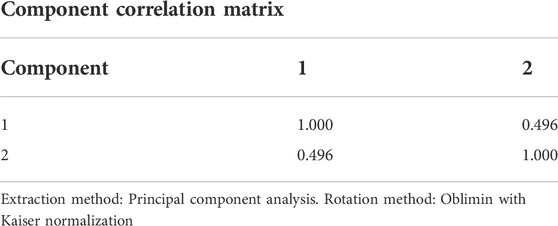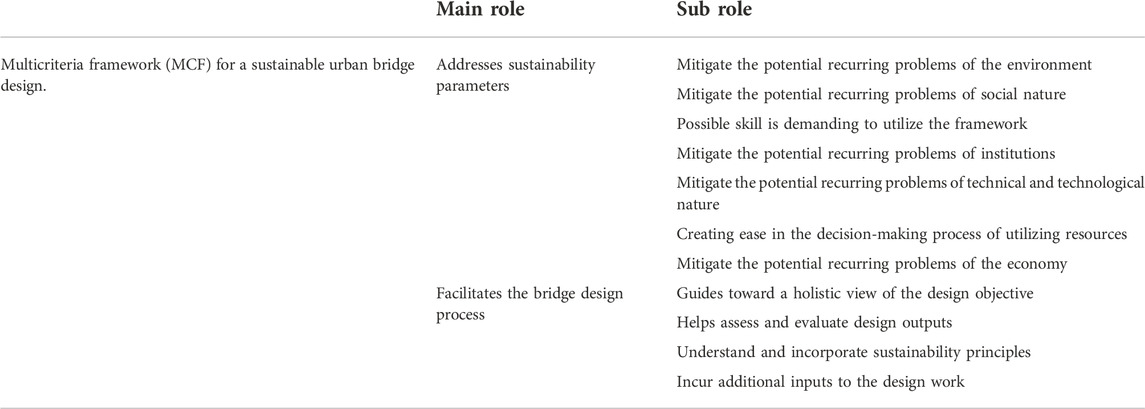- Ethiopian Institute of Architecture, Building Construction and City Development (EIABC), Addis Ababa University (AAU), Addis Ababa, Ethiopia
This research investigates the role of using a multicriteria framework during the process of designing a sustainable urban bridge. A framework is a basic structure underlying a system, concept, or method. It is a hypothetical depiction of a complex entity or process. On the other hand, a multicriteria framework comprises several criteria or attributes that relate to the widespread usage of difficult-to-understand ideas, concepts, and approaches. The general purpose of such a framework is to make it easier to apply sustainable urban bridge design for infrastructure improvement. A literature review and a questionnaire survey are used in the study to identify the most important roles. The survey study, using a structured questionnaire, was applied to samples (n = 204) of practicing professionals in an urban bridge infrastructure design. A principal component analysis was carried out to pinpoint the key components. As a result, the multicriteria framework predominantly addresses sustainability principles in design practice and also guides and facilitates all bridge design processes, from conceptual analysis to final design outputs.
Introduction
Designing urban bridges with the goal of achieving sustainability is becoming a top priority in the field of design studies (Bielefeldt, 2013; García-Segura et al., 2018). Sustainability aids in the consideration of the most fundamental aspects of any built infrastructure (Kibert, 2016). These main components that play a role in efficient whole-system design practice are linked to the consideration of sustainability (Buede and Miller, 2016; Hinge et al., 2020). The practice of these considerations, in other words, entails the concept of sustainability in the design of infrastructures. Sustainability in the design of urban bridges would be a core design issue while making design decisions. Sustainability is the responsible creation, operation, and management of a healthy infrastructure based on resource efficiency, technological adaptability, minimal environmental impact, optimum economy, and social equity for the present and future generations (Brundtland, 1987; Kibert, 2016; Ness and Xing, 2017).
A sustainable design requires significant social, economic, and environmental considerations during multilevel provisions of infrastructures (Brundtland, 1987; Edwards, 2005). Sustainable design is an alternative approach to conventional design that leads toward a less consumptive mindset and embraces global interdependence, environmental stewardship, social responsibility, and economic viability (Ehrenfeld, 2004; Edwards, 2005; Chapman, 2012). It is technologically systematic and considers the impact of design choices at different levels. The case of Ethiopian urban bridge design tends to be conventional and does not have a clear mechanism for how and why the requirements of the sustainability parameters are met (Urban Sustainability Exchange, 2016; Ethiopian Roads Authority, 2019; Okereke et al., 2019). The role of a multicriteria framework (MCF) in the decision-making process for sustainable urban bridge design would be vital in addressing the consideration of sustainability.
The design of urban bridges has more complex design problems. Urban bridges are essential for the seamless flow of commodities, services, and people (Allan et al., 2013). The design dynamics of urban bridges are linked to various aspects that must be addressed during the design process (Dunker and Rabbat, 1993). Multiple factors, each of which has its own set of requirements, make it difficult to handle the design process holistically.
A framework is a basic structure underlying a system, concept, or text that helps comprehend the prospective components and attributes of a hypothetical description of a complex entity or process, whereas a multicriteria framework is a framework that incorporates several criteria for determining the relationship between the widespread use of difficult-to-understand ideas, concepts, and approaches. Function, material type, safety in terms of strength, cost regarding its affordability, ecological impact, esthetics, comfort, and adaptability to the local context are factors addressed in the bridge design process by Radić and Kušter (2013); Hinge et al. (2020); and Zhenyong (2021). However, several aspects, such as technological adaptability, institutional culture, and others, must be considered during the urban bridge design process.
A multicriteria framework that consists of multiple attributes would facilitate the design of bridges found in urban regions towards attaining sustainability, ending poverty, ensuring healthy lives, ensuring inclusive and equitable quality education, achieving gender equality, and promoting sustained and inclusive economic growth. Moreover, making cities and human settlements inclusive, safe, resilient, and sustainable are just a few of the roles that sustainable infrastructures play in the sustainable development process (Robert et al., 2005).
The significance of these multicriteria frameworks in the design of sustainable urban bridges is recognized using literature findings and a survey study by determining the importance of each role in the design of sustainable urban bridges. The study used factorial analysis to describe many aspects since these techniques aid in the reduction of factors (Balasundaram, 2009). Principal component analysis (PCA) is one of the factorial studies that could be used to determine component-level role identification (Mackiewicz and Ratajczak, 1993).
The study aimed to respond to the question, “What are the main roles of a multicriteria framework in designing a sustainable urban bridge?” It is reconfiguring the framework’s significance with meaningful abstracts. The research is also delimited in the context of the Ethiopian Architecture, Engineering, and Construction (AEC) industry practice. Although analogs exist in other countries in the same context, the Ethiopian AEC design practice is thought to be in the transitional phase of the shift from conventional to sustainable design practices.
Methods
The research uses a quantitative methodology to identify the key roles of the multicriteria framework since the roles identified are subjectively assessed using a Likert-type (Vagias, 2006) scale of measurement with closed-end questions. The methodology quantifies the responses and tends to measure sufficient numerical data and responses (Abowitz and Toole, 2010; Fellows and Liu, 2021). The Likert measurement scale helps obtain the opinion of the respondent’s judgment (Teo and Ling, 2006; Joshi et al., 2015).
All the respondents’ (n = 204) subjective opinions were obtained using a survey questionnaire based on exposure and experiences from designers and researchers in the Architecture, Engineering, and Construction (AEC) industry. The first part of the survey questions collects the respondents’ background information. The second part collects the respondents’ level of agreement on the importance of the role of a multicriteria framework.
The demographic data collected from the respondents comprise the following sub-questions: the analysis of these parts of the study is descriptive, and cross-tabulations have been used to describe the nature of the demography.
The questions asked to address the objective of the study were framed by a Likert scale due to respondents having plenty of time to respond to each question. A five-point Likert scale is used in the study to measure the respondents’ levels of agreement (Vagias, 2006). The measurement scales are 1 = not important, 2 = less important, 3 = neutral, 4 = important, and 5 = very important. The research aimed to outline the key roles of a multicriteria framework for designing sustainable urban bridges in Ethiopia. Addressing the research objectives, recent literature reviews were collected, and the respondents were asked to rate them using the Likert scale provided.
Results
Demographic data
The demographic data of the respondents are stated below in the cross-tabulation of the level of education, areas of design experience, specialization based on their education and/or experience, and years of design experience in bridge infrastructure. Education, experience, and specialization are the main variables discussed in this subtopic.
The sample distribution in Figure 1 showed the level of education and the areas of design experience. Of the respondents’ experience in bridge design, about 30 professionals with master’s degrees were counted, whereas those with bachelor’s degrees were eight and three with Ph.D. degrees. Most respondents have experience in building design, with 60 having a bachelor’s degree and 52 having a master’s degree.
Figure 2 depicts the cross-tabulation between respondents’ specialization and years of design experience in bridge infrastructure. The number of professionals who specialize in bridge engineering with an experience of 6 years is 11. Six professionals have more than 6 years but less than 20 years of experience in total. There is also one practicing professional who has more than 20 years of experience in the bridge engineering area.
Data statistics
The role of the multiple criteria frameworks for sustainable urban bridge design was identified through an exploratory factor analysis. The data collected through a questionnaire survey have been cleaned, screened, and checked for data reliability using Cronbach’s alpha (Ekolu and Quainoo, 2019), which should be more than 0.5 (Vinodh and Joy, 2012). For N = 14 factors and a sample size of 204, it had a value of 0.904. This alpha value represents the perfect inter-reliability of the data; hence, the questionnaire study provides reliability for further analysis.
The role of the framework has been explored at the level of importance of factors. The research questions were organized in a Likert-scale system of measurement on a scale of 1–5. The level of importance taken was 1 = not important, 2 = low importance, 3 = neutral, 4 = important, and 5 = essential. The parameters in terms of their importance in the identification of key roles of a multicriteria framework for designing sustainable urban bridges were collected from the literature and then were sent to be rated by the respondents.
Based on the sampled data, the distribution of normality of the data shall be tested to determine its statistical testing method. As a result, the extent of the data distribution can be determined by determining the Shapiro–Wilk (Yap and Sim, 2011; Hanusz et al., 2016) significance level of the p-value and observing the frequency distribution and Q–Q plot. Therefore, based on the values of p = 0.001, from Table 1 test of normality, the sample data significantly deviated from the normally distributed population, which implies that the data were not normally distributed. Furthermore, by observing the skewness and kurtosis values of the descriptive statistics (Table 2 and Table 3) and the Q–Q plot (Figure 3), it can be seen that the data are not normally distributed. The data testing technique would be nonparametric, in which Spearman’s rank-order correlation (Schober et al., 2018) can be used as a statistical testing method.
The Spearman rank-order correlation was employed considering the data are monotonic (the value of one variable would increase or decrease as the value of the other variables increase or decrease), and the distribution of the data was linearly related. Table 3 shows Spearman’s rank-order correlation coefficient since the data variables are preferred to have a significant relationship with each other. The association is measured using the range of r values suggested by Schober et al. (2018) as absolute magnitude of the observed correlation coefficient interpretation, 0.00–0.10, negligible correlation, 0.10–0.39, weak correlation, 0.40–0.69 moderate correlation, 0.70–0.89 strong correlation, and 0.90–1.00 very strong correlation.
Table 3 clearly shows that the eleven variables illustrated showed a 1% significant level with a moderate association in the same direction. For example, there is a significant moderate correlation between technical and technological mitigation and environmental mitigation toward the role of MCF in attaining sustainability (r = 0.696, p = 0.000, N = 204). In addition, there is also a high significance level in the holistic guidance capability of the MCF and its ability to assess the sustainable urban bridge design with a moderately correlated association (r = 0.690, p = 0.000, N = 204). Whereas the other variables that have a weak degree of correlation are, for example, the level of environmental mitigation over the level of holistic guidance of the design practice (r = 0.237, p = 0.001, N = 204).
Exploratory factor analysis
Identifying the key roles has been analyzed using the principal component analysis (PCA) extraction techniques. PCA extraction analysis helps underline the main role of a large number of factors (Mackiewicz and Ratajczak, 1993; Shrestha 2021) Data can be considered for PCA analysis if the KMO (Kaiser–Meyer–Olkin) measure of sampling is adequate (>0.5) and if Bartlett’s test of sphericity is significant (<0.05) (Abdi and Williams, 2010; Bro and Smilde, 2014). The test for both requirements was acceptable with a KMO = 0.841 and a significance of sphericity of 0.001 (Table 4).
Using the PCA extraction method of factors which loads into common variance are listed below in the communality’s extraction and oblique rotation (Oblimin method) using Kaiser normalization so that it has a better than orthogonal rotation in the sense of generating stable correlations among the loadings (Costello and Osborne, 2005; Gerbing and Hamilton, 1996; Finch, 2011) (Table 5). Most of the correlation coefficients are more than 0.3, and they all are significant factors with a significance value of 0.001, which is within the acceptable range of value (<0.05). The correlation is positive, and it has a direct relationship with factors.
Therefore, the eleven (11) commonalities extracted by using the Oblimin rotation method are reasonable, and the extracted loadings which have a loading value of more than 0.5 are listed in Table 6. The extractions have a minimum of 0.557 and a maximum of 0.800 loadings. The total variance is also explained in Table 7.
The components that explained the total variance of the factors were components 1 and 2, with a cumulative extraction sum of squared loadings (66.658%). This total variance percentage is within the standard value of more than 60% (Mackiewicz and Ratajczak, 1993; Pallant, 2020).
Components with an eigenvalue of more than one that explain the majority of the total variance had key roles in the MCF (Figure 4). The scree plot illustrates the loadings of all 11 factors, although the greater common variance is explained by component 1.
The computation of eigenvalues using a parallel analysis with Monte Carlo PCA (Watkins, 2006) is shown in Figure 5, and it justifies the two-component load less than the result of scree plot findings using the PCA extraction method.
Table 8 explains the pattern matrix of factors in two components, seven of the factors load on component 1 while the remaining factors load to component 2.
The component matrix of Table 9 validates the result since the components strongly correlate with a value of about 0.5 which is less than 0.7, and the self-correlation is greater than the cross-correlation (1.00 > 0.496). The reliability of the component factors for N = 11 factors is measured with a Cronbach’s alpha of 0.915, which is acceptable when it is compared to the standard value of 0.700.
The role of a multicriteria framework for designing a sustainable urban bridge was clearly identified based on the suggestions given by the experts as per the literature’s recommendation presented in Table 10. The key roles are categorized as main roles and sub-roles. The sub-roles were arranged by their level of importance from high–low for each main role.
Discussion
In this section, the results are outlined as a principal component, which is a key role of the multicriteria framework for the sustainable urban bridge design process. The findings are divided into two categories: main roles and sub-roles, which explain the function of the multicriteria framework. Moreover, the discussion includes an interpretation of the results from the point of view of the existing literature.
Addressing sustainability
The benefits of a framework with various qualities are numerous, and it is particularly useful in tackling the issue of sustainability. In a nutshell, a framework is a hypothetical description of a complex entity or process, or it is the essential structure that underpins a system, notion, or literature. However, a multicriteria framework is defined as a framework that incorporates several criteria for determining the relationship between the widespread adoption of difficult-to-understand ideas, concepts, and approaches.
The utilization of an MCF in the design process would mitigate the potential recurring problems for the environment. Resource depletion due to the high consumption of natural resources creates an imbalance in ecology. These resources are depleted without due consideration for their scarcity in the construction of the built environment. The excessive use of resources by exerting energy on manufacture, transport, and assemblage also emits large amounts of carbon dioxide (CO2), pollutes the natural environment, and drastically changes the climate, affecting humanity (Kibert, 2013).
One of the strangest aspects of humanity is that it consumes a massive amount of resources, even non-renewable ones, leaving traces of pollution in the process. To make matters worse, most resources are consumed by a small number of countries. This indicates that when the bulk of humanity can afford the same spending behaviors, the process will deteriorate (Pacheco-Torgal and Labrincha, 2013).
Sustainability principles would be addressed by using the MCF through mitigating the potentially recurring problems of social, economy, institutional, technical, and technological issues. In the construction and renovation of buildings, there is a growing understanding of the need to use materials with lower social, economic, and environmental consequences (Pedroso, et al., 2017). However, in the case of infrastructure such as urban bridges, there is a lack of knowledge of resource consumption throughout the delivery of such structures. Construction materials are essential in the supply of urban bridges because they are extracted from the natural environment, transported to the construction site, processed, fabricated on-site, and built into the infrastructure.
In regard to technological change, whether it is in the essence of information technology toward construction, construction techniques, equipment, or material advancement for the realization of the infrastructure, the change is rapid and continuous, not as such debatable. However, in 1998, this was not the same; Levinthal states that discussions of technological transformation have provided drastically opposing viewpoints as technological progress should be steady and incremental or technological development as rapid and discontinuous (Levinthal, 1998). This argument is currently changing differently; the process, speed, and extent of change have an impact on the delivery of our infrastructures.
According to Tatum (1988a), the components and elements of construction technology include construction-applied resources (information, skills, equipment, time, energy, tools, etc), materials and permanent equipment resources, construction processes (methods and tasks), and project requirements and constraints (Tatum, 1988a; Tatum, 1988b). There are also major driving factors to consider in the application of construction technology in our built environment: the increasing technical complexity of constructed facilities, owners facing increasing international competition demanding more of designers and constructors, and the size, diversity, and state of technology (Tatum, 1988b). The construction industry’s efficiency and competitiveness can only be increased by transferring and implementing computing and other sophisticated technology (Koskela and Kazi, 2003; Loosemore and Forsythe, 2019).
Continuous advances in sensor and data collection technology have allowed the installation of large monitoring systems on a variety of structures (Pipinato and De Miranda, 2022). Recent advancements in lean construction and BIM-based design and construction management are extremely beneficial to the long-term delivery of infrastructure, whether it is a bridge or a road.
On the other hand, using a multicriteria framework effectively requires a high level of competence, yet doing so will result in easier decisions about how to use resources. A new design theory known as “circularity” seeks to transform the linear model of modern material resource usage into a circular one that is considered healthy and operates in a closed loop by minimizing harmful impacts (Shady, 2018). Design and sustainability concerns will be based on the circular idea. By decoupling economic development from resource use, the circular economy (CE) promotes a more resource-efficient approach. The model is based on several theories, including industrial ecology, regenerative design, performance economy, and biomimicry (Van Stijn and Gruis, 2020). The three principles that constitute the CE model are described as follows: “1) preserve and enhance natural capital by controlling finite stocks and balancing renewable resource flows; 2) optimize resource yields by circulating products, components, and materials at their highest utility at all times in both technical and biological cycles; 3) foster system effectiveness by revealing and designing out negative externalities” (MacArthur, 2013; Mendoza et al., 2017).
Facilitating the bridge design process
The esthetic and visual quality of a bridge can be assessed using a variety of criteria and approaches. It is necessary to identify the basic criteria that will serve as the foundation for the establishment of a multicriteria assessment technique for the evaluation of new and existing bridges. It is necessary to systematize esthetic evaluation criteria and construct a multicriteria analysis approach for use in the design of esthetically pleasing bridges to improve the esthetic quality of bridges (Rozentale and Paeglitis, 2017).
According to Gauvreau et al. (2002), if bridge design is to be regarded as a viable and distinct form of artistic expression, it must reflect the truths that characterize the underlying essence shared by all works of art, regardless of the medium. By extension, for these facts to be incorporated into bridges, they must first be acknowledged in the conceptual frameworks that designers employ to guide their decisions during the design process Gauvreau et al. (2002).
Infrastructure sustainability has received a lot of interest (McCormick et al., 2013). The first way to produce a sustainable design is to optimize energy and material consumption in a specific built environment. The second way is to attempt an alternative new technique that aids in seeing the design objective/context/problem in a way that can be addressed in a systemic approach. The usage of frameworks and models would make the design objectives for sustainable infrastructure more understandable. When technology such as BIM provides a platform capable of capturing dynamic data that affect the performance and level of service in infrastructure projects, the architecture of the framework forms a learning cycle for critical thinking.
According to Pollalis, et al., (2012) the three main components of quality of life are social, sustainable, and affordable. We can obtain a rich quality of life when we create a balance among these three factors that make up the triple bottom line. Through the careful design of the physical environment and its supporting infrastructure, planners, architects, and engineers can improve all three areas of people’s lives.
A multicriteria framework guides toward a holistic view of the design objective and helps assess and evaluate design outputs. A tighter urban grain, a complex hierarchy of street and access patterns, concentration and proximity of residential and commercial buildings to each other, the central core of the city, access to public transportation, a variety of options for walking and cycling, mature tree cover, and landscaping combine to create an attractive, mature, and durable form and character, encompassing most of the prerequisites for a sustainable form of development (França et al., 2017).
Blizzard and Klotz 2012 have formulated a framework for sustainable whole-system design practice. Engineers, architects, planners, and policymakers can use the processes, ideas, and methodologies extracted from the literature in a range of design disciplines, including the design of sustainable cities and infrastructure. Frameworks detailing the full system design process, concepts, and methodologies would facilitate the design process.
The overall design process necessitates an early involvement with highway planning to influence road alignments for the sake of bridge geometry and esthetics (Liu, 2009; Dobbins, 2011). Surface water must be evacuated off the deck, which necessitates a sufficient longitudinal gradient. Changes in the deck’s gradient or horizontal alignment might cause the deck to appear twisted and should be avoided. If the deck must accept a curved horizontal road alignment, we must ensure the radius and superelevation remain consistent throughout the length (Malekly et al., 2010). If the bridge crosses another road, the road below must have an adequate vision through the bridge opening to meet the required overtaking and stopping sight distances. The positions of the piers or abutments may need to be changed to attain the correct sight lines. Furthermore, understanding and incorporating sustainability principles would be essential in executing a sustainable urban bridge design (Maier et al., 2012), while using MCF. Moreover, it also incurs additional inputs to the design work and would demand a facilitating tool or protocol in a sustainable urban bridge design assignment.
Conclusion
In terms of the existing economic, social, and environmental impact, the role of developing and implementing a multicriteria framework for sustainable urban bridge design in Ethiopia has become critical. The design process of urban bridge demands meets the sustainability criteria since there are resource limitations, urban population growth, and a limited economy. The research delineates the key components of the multicriteria framework in the design of bridge infrastructure. The roles identified in the research are to mitigate the potentially recurring problems of an environmental, social, institutional, technical, technological, and economic nature. The production of a design product would not be simply an input, process, and output of activity; rather, it would demand a holistic understanding and execution. Furthermore, possible skills are demanded to utilize the framework, creating ease in the decision-making process of utilizing resources. Guidance toward a holistic view of the design objective helps assess and evaluate the design outputs, understand and incorporate sustainability principles, and incur additional inputs to the design work.
Data availability statement
The raw data supporting the conclusion of this article will be made available by the authors, without undue reservation.
Author contributions
Both authors contributed to the study’s conception and design. Document preparation, data collection, and analysis were performed by LH. The first draft of the manuscript was also written by LH, and both authors commented on previous versions of the manuscript. Both authors read and approved the final manuscript.
Acknowledgments
The authors of this work would like to recognize the funding for data collection for this study granted by the graduate program at Addis Ababa University.
Conflict of interest
The authors declare that the research was conducted in the absence of any commercial or financial relationships that could be construed as a potential conflict of interest.
Publisher’s note
All claims expressed in this article are solely those of the authors and do not necessarily represent those of their affiliated organizations, or those of the publisher, the editors, and the reviewers. Any product that may be evaluated in this article, or claim that may be made by its manufacturer, is not guaranteed or endorsed by the publisher.
References
Abdi, H., and Williams, L. (2010). Principal component analysis. WIREs. Comp. Stat. 2 (4), 433–459. doi:10.1002/wics.101
Abowitz, D., and Toole, T. (2010). Mixed method research: Fundamental issues of design, validity, and reliability in construction research. J. Constr. Eng. Manage. 136 (1), 108–116. doi:10.1061/(asce)co.1943-7862.0000026
Allan, P., Bryant, M., Wirsching, C., Garcia, D., and Teresa Rodriguez, M. (2013). The influence of urban morphology on the resilience of cities following an earthquake. J. Urban Des. 18 (2), 242–262. doi:10.1080/13574809.2013.772881
Balasundaram, N. (2009). Factor analysis: Nature, mechanism and uses in social and management science research. J. Cost Manag. Account. Bangladesh 37 (2), 15–25.
Bielefeldt, A. (2013). Pedagogies to achieve sustainability learning outcomes in civil and environmental engineering students. Sustainability 5 (10), 4479–4501. doi:10.3390/su5104479
Blizzard, J., and Klotz, L. (2012). A framework for sustainable whole systems design. Design Studies 33 (5), 456–479. doi:10.1016/j.destud.2012.03.001
Bro, R., and Smilde, A. (2014). Principal component analysis. Anal. Methods 6 (9), 2812–2831. doi:10.1039/c3ay41907j
Brundtland, G. (1987). Our common future: The world commission on environment and development. Oxford: Oxford University Press.
Buede, D., and Miller, W. (2016). The engineering design of systems: Models and methods. 3rd edition. New Jersy: John Wiley & Sons.
Chapman, J. (2012). Emotionally durable design: Objects, experiences and empathy. 3rd edition. London: Routledge.
Costello, A., and Osborne, J. (2005). Best practices in exploratory factor analysis: Four recommendations for getting the most from your analysis. Pract. Assess. Res. Eval. 10 (1), 7. doi:10.7275/jyj1-4868
Dunker, K., and Rabbat, B. (1993). Why America’s bridges are crumbling. Sci. Am. 268 (3), 66–72. doi:10.1038/scientificamerican0393-66
Edwards, A. (2005). The sustainability revolution: Portrait of a paradigm shift. 1st edition. Canada: New Society Publishers.
Ekolu, S., and Quainoo, H. (2019). Reliability of assessments in engineering education using Cronbach’s alpha, KR and split-half methods. Glob. J. Eng. Educ. 21 (1), 24–29.
Ethiopian Roads Authority (2019). Ethiopian roads authority: Roadworks in Ethiopia. Available at: http://www.era.gov.et (Accessed May 05, 2019).
Finch, W. (2011). A comparison of factor rotation methods for dichotomous data. J. Mod. App. Stat. Meth. 10 (2), 549–570. doi:10.22237/jmasm/1320120780
França, C., Broman, G., Robert, K. H., Basile, G., and Trygg, L. (2017). An approach to business model innovation and design for strategic sustainable development. J. Clean. Prod. 140 (1), 155–166. doi:10.1016/j.jclepro.2016.06.124
García-Segura, T., Penadés-Plà, V., and Yepes, V. (2018). Sustainable bridge design by metamodel-assisted multi-objective optimization and decision-making under uncertainty. J. Clean. Prod. 202 (1), 904–915. doi:10.1016/j.jclepro.2018.08.177
Gauvreau, P., Gerbing, D., and Hamilton, J. (2002). The three myths of bridge aesthetics.Developments in short and medium span bridge engineering, toronto, Canada: AcademiaViability of exploratory factor analysis as a precursor to confirmatory factor analysis. Struct. Equ. Model. A Multidiscip. J. 3 (1), 62–72. doi:10.1080/10705519609540030
Gerbing, D., and Hamilton, J. (1996). Viability of exploratory factor analysis as a precursor to confirmatory factor analysis. Structural Equation Modeling: A Multidisciplinary Journal 3 (1), 62–72. doi:10.1080/10705519609540030
Hanusz, Z., Tarasinska, J., and Zielinski, W. (2016). Shapiro–Wilk test with known mean. REVSTAT-Statistical J. 14 (1), 89–100.
Hinge, G., Surampalli, R., and Goyal, M. (2020). “Sustainable infrastructure,” in Sustainability: Fundamentals and applications. Editor R. Y. Surampalli (London: John Wiley & Sons), 295–311.
Joshi, A., Kale, S., Chandel, S., and Pal, D. (2015). Likert scale: Explored and explained. Br. J. Appl. Sci. Technol. 7 (4), 396–403. doi:10.9734/bjast/2015/14975
Kibert, C. J. (2013). Sustainable construction: Green building design and delivery. 3rd ed. New Jersy: John Wiley & Sons,INC.
Kibert, C. (2016). Sustainable construction: Green building design and delivery. 4th edition. New Jersy: John Wiley & Sons.
Koskela, L., and Kazi, A. (2003). “Information technology in construction: How to realise the benefits?,” in In: Socio-Technical and human cognition elements of information systems. Editor E. W. Steve Clarke (Hershey, PA: Information Science Publishing), 60–75.
Levinthal, D. A. (1998). The slow pace of rapid technological change: Gradualism and punctuation in technological change. Industrial Corp. Change 7 (2), 217–247. doi:10.1093/icc/7.2.217
Liu, J. (2009). Parametric model for assessing factors that influence highway bridge service life. Blacksburg, VA: Virginia State University.
Loosemore, M., and Forsythe, P. (2019). “Sustainable construction technology adoption,” in Sustainable construction technologies: Life cycle assessment. Editor V. W. T. A. K. N. Le (Oxford: Butterworth-Heinemann), 300–318.
MacArthur, E. (2013). Towards the circular economy: Economic and business rationale for an accelerated transition. Cowes: Ellen MacArthur Foundation. Available at: www.ellenmacarthurfoundation.org/publications/towards-the-circular-economy-vol-1-an-economic-and-business-rationale-for-an-accelerated-transition.
Mackiewicz, A., and Ratajczak, W. (1993). Principal components analysis (PCA). Comput. Geosciences 19 (3), 303–342. doi:10.1016/0098-3004(93)90090-r
Maier, P., Pfaffinger, M., Kuhlmann, U., and Maer, P. (2012). “German approach to a holistic assessment of steel and composite bridges:IABMAS 2012 - 6th International Conference on Bridge Maintenance, Safety and Management,” in IABMAS 2012-6th international conference on bridge maintenance, safety and management (Milano: Informa UK Limited), 76.
Malekly, H., Mousavi, S., and Hashemi, H. (2010). A fuzzy integrated methodology for evaluating conceptual bridge design. Expert Syst. Appl. 37 (7), 4910–4920. doi:10.1016/j.eswa.2009.12.024
McCormick, K., Anderberg, S., Coenen, L., and Neij, L. (2013). Advancing sustainable urban transformation. J. Clean. Prod. 50, 1–11. doi:10.1016/j.jclepro.2013.01.003
Mendoza, J. M. F., Sharmina, M., Gallego-Schmid, A., Heyes, G., and Azapagic, A. (2017). Integrating backcasting and eco-design for the circular economy: The BECE framework. J. Industrial Ecol. 21 (3), 526–544. doi:10.1111/jiec.12590
Ness, D., and Xing, K. (2017). Toward a resource-efficient built environment: A literature review and conceptual model. J. Industrial Ecol. 21 (3), 572–592. doi:10.1111/jiec.12586
Okereke, C., Coke, A., Geebreyesus, M., Ginbo, T., Wakeford, J. J., Mulugetta, Y., et al. (2019). Governing green industrialisation in Africa: Assessing key parameters for a sustainable socio-technical transition in the context of Ethiopia. World Dev. 115, 279–290. doi:10.1016/j.worlddev.2018.11.019
Pacheco-Torgal, F., and Labrincha, J. A. (2013). The future of construction materials research and the seventh UN millennium development goal: A few insights. Constr. Build. Mater. 40, 729–737. doi:10.1016/j.conbuildmat.2012.11.007
Pallant, J. (2020). SPSS survival manual: A step by step guide to data analysis using ibm SPSS. London: Routledge.
Pedroso, M., De Brito, J., and Silvestre, J. D. (2017). Characterization of eco-efficient acoustic insulation materials (traditional and innovative). Constr. Build. Mater. 140, 221–228. doi:10.1016/j.conbuildmat.2017.02.132
Pipinato, A., and De Miranda, M. (2022). “Steel and composite bridges,” in Innovative bridge design handbook. Editor A. Pipinato (USA: Butterworth-Heinemann), 327–352.
Pollalis, S., Georgoulias, A., Ramos, S., and Schodek, D. (2012). Infrastructure sustainability and design. 1st ed. London: Routledge.
Radić, J., and Kušter, M. (2013). “Aesthetics and sustainability of arch bridges,” in In proc. 7th int. Conf. Arch bridg.–ARCH 2013 (Kušter, Marija ; Šavor, Zlatko: Zagreb University), 13–28.
Robert, K., Parris, T., and Leiserowitz, A. (2005). What is sustainable development? Goals, indicators, values, and practice. Environ. Sci. policy Sustain. Dev. 47 (3), 8–21. doi:10.1080/00139157.2005.10524444
Rozentale, I., and Paeglitis, A. (2017). Criteria for assessment of bridge aesthetic and visual quality. IOP Conf. Ser. Mat. Sci. Eng. 215 (1), 012073. doi:10.1088/1757-899x/251/1/012073
Schober, P., Boer, C., and Schwarte, L. (2018). Correlation coefficients: Appropriate use and interpretation. Anesth. Analgesia 126 (5), 1763–1768. doi:10.1213/ane.0000000000002864
Shady, A. (2018). Net zero energy buildings (NZEB). Concepts frameworks and roadmap for project analysis and implementation. London: Elsevier.
Shrestha, N. (2021). Factor analysis as a tool for survey analysis. Am. J. Appl. Math. Statistics 9 (1), 4–11. doi:10.12691/ajams-9-1-2
Tatum, C. B. (1988b). Classification system for construction technology. J. Constr. Eng. Manage. 114 (3), 344–363. doi:10.1061/(asce)0733-9364(1988)114:3(344)
Tatum, C. B. (1988a). Technology and competitive advantage in civil engineering. J. Prof. Issues Engrg. 114 (3), 256–264. doi:10.1061/(asce)1052-3928(1988)114:3(256)
Teo, E., and Ling, F. (2006). Developing a model to measure the effectiveness of safety management systems of construction sites. Build. Environ. 41 (11), 1584–1592. doi:10.1016/j.buildenv.2005.06.005
Urban Sustainability Exchange (2016). Development of sustainable transport system, Addis Ababa, Ethiopia. Available at: https://use.metropolis.org/case-studies/sustainable-transport-in-addis-ababa (Accessed July 26, 2021).[
Vagias, W. M. (2006). “Likert-type scale response anchors,” in Clemson international institute for tourism & research development, department of parks (Recreation and Tourism Management, USA: Clemson University).
Van Stijn, A., and Gruis, V. (2020). Towards a circular built environment: An integral design tool for circular building components. Smart Sustain. Built Environ. 9 (4), 635–653. doi:10.1108/sasbe-05-2019-0063
Vinodh, S., and Joy, D. (2012). Structural equation modeling of sustainable manufacturing practices. Clean. Techn. Environ. Policy 1 (79-84), 79–84. doi:10.1007/s10098-011-0379-8
Watkins, M. (2006). Determining parallel analysis criteria. J. Mod. App. Stat. Meth. 5 (2), 344–346. doi:10.22237/jmasm/1162354020
Yap, B., and Sim, C. (2011). Comparisons of various types of normality tests. J. Stat. Comput. Simul. 81 (12), 2141–2155. doi:10.1080/00949655.2010.520163
Keywords: key role, multicriteria framework, sustainable design, urban bridge, Ethiopia
Citation: Hailemariam LM and Nuramo DA (2022) Identifying the key roles of a multicriteria framework for designing sustainable urban bridges in Ethiopia. Front. Built Environ. 8:1080455. doi: 10.3389/fbuil.2022.1080455
Received: 26 October 2022; Accepted: 23 November 2022;
Published: 07 December 2022.
Edited by:
Shehata E. Abdel Raheem, Assiut University, EgyptReviewed by:
Sherif Mourad, Cairo University, EgyptMaha Moddather Hassan, Cairo University, Egypt
Obinna Madubuike, University of Florida, United States
Copyright © 2022 Hailemariam and Nuramo. This is an open-access article distributed under the terms of the Creative Commons Attribution License (CC BY). The use, distribution or reproduction in other forums is permitted, provided the original author(s) and the copyright owner(s) are credited and that the original publication in this journal is cited, in accordance with accepted academic practice. No use, distribution or reproduction is permitted which does not comply with these terms.
*Correspondence: Leule M. Hailemariam, bGV1bGUubWVicmF0aWVAZWlhYmMuZWR1LmV0
 Leule M. Hailemariam
Leule M. Hailemariam Denamo A. Nuramo
Denamo A. Nuramo